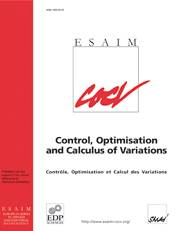Article contents
A Variational Problem Modelling Behavior of Unorthodox Silicon Crystals
Published online by Cambridge University Press: 15 September 2003
Abstract
Controlling growth at crystalline surfaces requires a detailed and quantitative understandingof the thermodynamic and kinetic parameters governing mass transport. Many of theseparameters can be determined by analyzing the isothermal wandering of steps at a vicinal[“step-terrace”] type surface [for a recent review see [4]]. In the case of orthodoxcrystals one finds that these meanderings develop larger amplitudes as the equilibriumtemperature is raised (as is consistent with the statistical mechanical view of themeanderings as arising from atomic interchanges). The classical theory due to Herring,Mullins and others [5], coupled with advances in real-time experimental microscopytechniques, has proven very successful in the applied development of such crystallinematerials. However in 1997 a series of experimental observations on vicinal defects ofheavily boron-doped Silicon crystals revealed that these crystals were quite unorthodox inthe sense that a lowering of the equilibrium temperature led to increased amplitude for theisothermal wanderings of a step edge [3]. In addition, at low temperatures the stepprofile adopted a periodic saw-tooth structure rather than the straight profile predicted by the classical theories. This article examines a stored free energy model for such crystals involving a (higher order) Landau/de Gennes type {``}order parameter{"} term and provides a proof for the existence of a minimizer.
Information
- Type
- Research Article
- Information
- Copyright
- © EDP Sciences, SMAI, 2003
References
- 4
- Cited by

